Open Access Principles
Central understands research to be ‘a process of investigation leading to new insights, effectively shared’ (Research Excellence Framework, 2019, Annex C). As part of our broader initiatives toward building and sustaining an open research environment, we support ethical, responsible management and sharing of outputs for the benefit of researchers as well as the wider community. Central is committed to:
Facilitating the widest access to our research, which produces the best chance of our methods and insights being used by a range of colleagues and communities, and ultimately contributes to a healthier and more inclusive research ecosystem.
Applying our expertise in the arts and humanities to increasing the accessibility of all modes of research, including both print and practice research outputs.
Meeting and exceeding our obligations as recipients of public funding to make Central research widely available. We encourage all creators to follow the access criteria laid out for REF 2021, regardless of academic pathway (see Appendixes 1 & 2).
Maintaining a non-commercial Institutional Repository as an accurate and up-to-date record of Central’s scholarly and creative outputs. Outputs can be discovered free online, worldwide, and downloaded subject to publisher embargos and other relevant exceptions (see Appendix 3).
Encouraging creators to explore all Open Access options to make significant outputs freely available. In addition to self-archiving in our Institutional Repository, other methods may include publishing in Open Access journals and applying for Research funds for paid access in transitional journals when appropriate and/or necessary (see Appendix 4).
Taking a broad and ethical approach to the open sharing of specific, cultivated, and curated research data in many forms. This includes developing thoughtful data management plans, with contextual documentation and holistic strategies for storage, management, and access (see Appendix 5).
Matters related to Open Access should be referred in the first instance to Research Services, by sending an email to research@cssd.ac.uk, using the subject heading “Open Access.” Enquiries will be handled by the Manager of the Institutional Repository, by the Head of Digital Research, or by the Chair of the Research Ethics and Integrity Subcommittee, as appropriate.
This policy was last reviewed by Research Committee on 16 March 2022
Open Access Appendices
-
Appendix 1: REF 2021 Open Access Policy
This appendix will be updated when guidelines are released for the next research assessment exercise. In the meantime, the REF 2021 guidelines referenced by Appendix 1 continue to apply to scholarly and research outputs until revised Open Access protocols are published.
From the 1st April 2016 to the 31st December 2020, creatorsmust meet REF 2021 Open Access (OA) requirements for journal articles and conference papers with ISSNs. The following outputs do not need to meet the criteria outlined below: monographs; non-text outputs, including practice; working papers; underpinning data; confidential reports. The full requirements are listed in the REF 2021 guidelines (Research Excellence Framework, 2019, paragraphs 223-255).
Below is a summary of the key points.
Gold Route Access
1. Gold Route journal articles must be available free of charge at point of publication on the publisher’s website with links included in the Institutional Repository (IR). Please see the FAQs (Appendix 4) regarding funding for paid Open Access.
Green Route Access
2. Between 1st April 2016 and 1st April 2018, Green Route journal articles and conference papers with ISSNs must be uploaded to the IR as soon as possible after acceptance and no more than three months after publication.
3. From the 1st April 2018, Green Route journal articles and conference papers with ISSNs must be uploaded to the IR within three months of publisher acceptance. The date of acceptance is the date the publisher confirms receipt of the article in an email or a letter. The acceptance date applies even if a publication date has not been agreed. See the FAQs (Appendix 4) for more on self-archiving.
4. Embargo periods are set by publishers and the maximum permitted embargo period is 24 months for REF Main Panel C and D. Journal articles and conference papers with ISSNs need to be fully accessible no later than one month after the embargo ends. Providing the embargo period is correctly set, the IRautomatically releases the document on the correct date.
Exceptions
If the dates above are not met, “exceptions” can be applied to journal articles and conference papers with ISSNs (Research Excellence Framework, 2019, paragraphs 252-255). REF 2021 accepts a 5% tolerance rate for Green Route journal articles and conference papers with ISSNs deposited outside of a recognised exception.
-
Appendix 2: UKRI Open Access Policy (2021)
From the dates listed below, UKRI Open Access Policy sets out how funded1 projects must meet the following Open Access requirements (UKRI, 2021a).
Compliance with the UKRI Open Access Policy for researchers on UKRI-funded projects will be sufficient to meet the OA mandate for future assessment exercises. Those outputs will not be expected to meet a second, different set of OA requirements (UKRI, 2021b, p.1)
Below is a summary of the key points.
1. Peer reviewed research articles and conference proceedings with ISSNs submitted for publication on or after the 1st April 2022, must follow one of the routes below:
Route 1
The Version of Record should be made freely available via the journal or publisher’s website immediately.Route 2 (Green route)
The Author’s Accepted Manuscript should be made available from the IR at time of publication. An embargo period is not permitted.
2. Research based monographs, book chapters and edited collections published on or after the 1st January 2024, must be freely available online via the IR, publication platform or publisher’s website within twelve months of publication.
3. Licence Requirements
The research must be attributed with a CC-BY Licence, or exceptionally, a CC-BY-ND licence, or another licence permitted by the UKRI. Guidelines to applying for exceptions can be found in (UKRI, 2021, paragraph 11b).4. In-scope articles require a Data Access Statement. This informs readers where they can find underlying research materials associated and how they can be accessed. Data can include code, software, numerical scores, textual records, images, sounds, objects and manuscripts. Where data is restricted, the statement should address the reasons.
1Applies to research that acknowledges funding from UKRI or any of its councils including: Arts and Humanities Research Council (AHRC), Biotechnology and Biological Sciences Research Council (BBSRC), Engineering and Physical Sciences Research Council (EPSRC), Economic and Social Research Council (ESRC), Innovate UK (IUK), Medical Research Council (MRC), Natural Environment Research Council (NERC), Research England (RE), Science and Technology Facilities Council (STFC). For details of each funders open access requirements, please refer to the Terms and Conditions of your funding scheme. An exception to this includes UKRI Training grants.
-
Appendix 3: Guide to Depositing Outputs in the Institutional Repository
For support regarding any aspect of depositing outputs into the Institutional Repository, please contact the Manager of the Institutional Repository (repository@cssd.ac.uk). Matters related to Open Access should be referred in the first instance to Research Services, by sending an email to research@cssd.ac.uk, using the subject heading “Open Access.”
A. Logging onto the Institutional Repository (IR)
1. Go to http://crco.cssd.ac.uk/
2. Click on “LOGIN” - top right hand corner - using your MyCentral log in details.
B. If you are using the IR for the first time, create your profile
1. Click on profile. This will take you to your profile.
2. Click on edit.
3. Now complete your profile by filling in all the boxes with your information.
4. When you have completed the form, click on save and return.
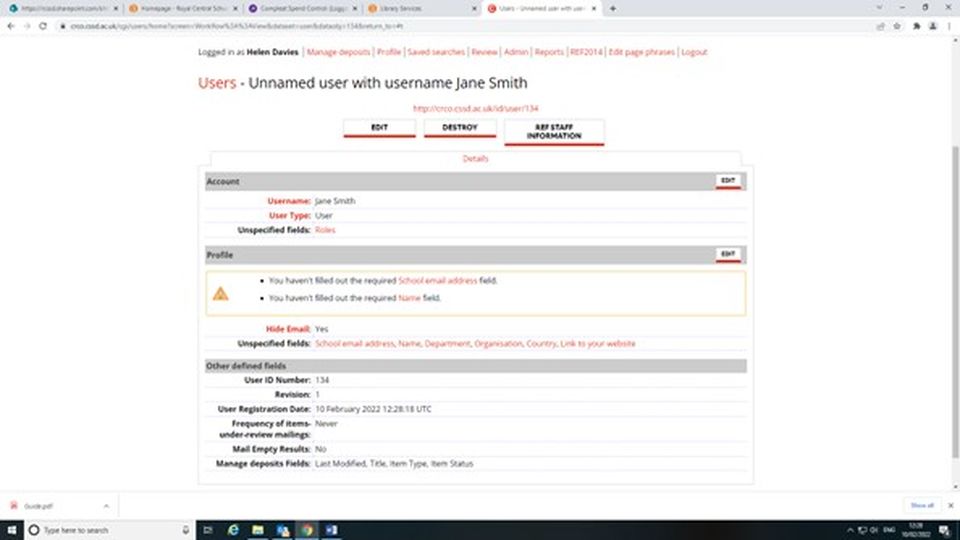
C. Depositing an output into the Institutional Repository.
1. Click on Manage Deposits.
2. Click on New Item.
3. Complete the Item Type page indicating the type of output you are depositing. Only one item type can be deposited at a time.
4. Click Next
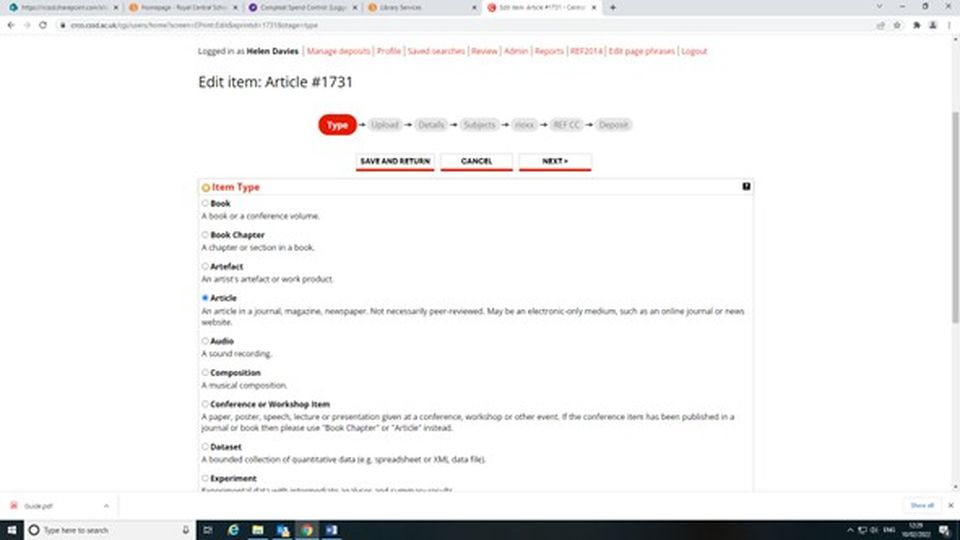
5. Complete the Upload page
a) For journal articles and other print materials:
If the output is available openly online, select From URL on the right-hand tab (entitled URL) and copy and paste a link to your website or the publisher’s website which holds your output.
Alternatively, select Choose File, and browse to select a Word, PDF or other file to upload from your computer. If you have rights to upload the publisher’s final PDF (the Version of Record), please use that file.
Most often with articles, you will be uploading the Author’s Accepted Manuscript as a Word/PDF document. If so, please use the following style:
A header that includes all the necessary citation information (author name, output title, publication, etc.);
Arial font, size 12;
1.5 spacing between lines, with an additional line between paragraphs;
Align left, with 1-1.5 inch margins;
For further access guidelines please see the Disability Unit website.
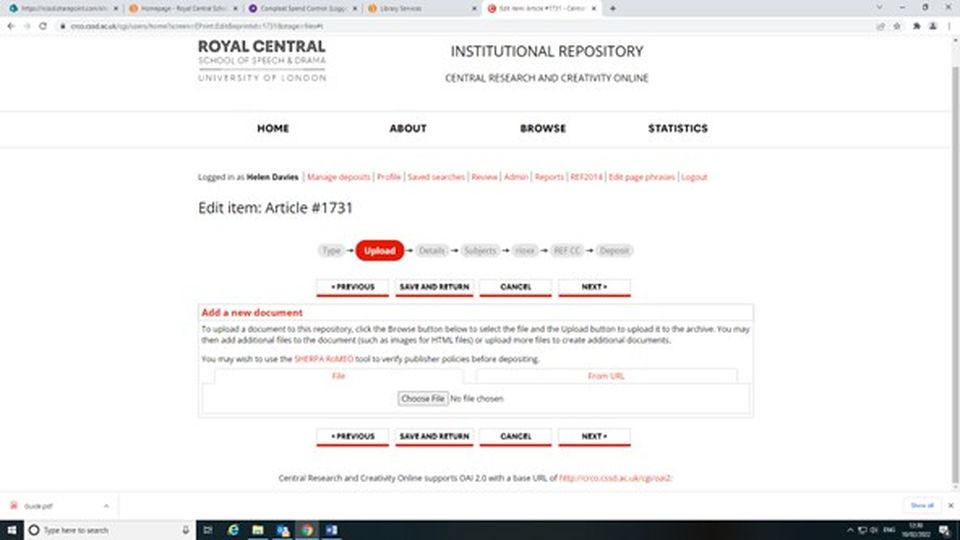
(b) The IR supports a range of audio and visual materials. Please choose as many files as you would like, one by one, and select the appropriate file type when you fill out the metadata (see 6). The full range of file types is visible in the screenshot.
(c) For Theses: please read the Deposit of Theses Policy 2017-2022 and complete Form 1: Submission and Deposit Agreement of Thesis for Research Degrees. This is available on Brightspace. In addition to uploading to the IR, send this form with a PDF copy of your thesis to research@cssd.ac.uk and repository@cssd.ac.uk.
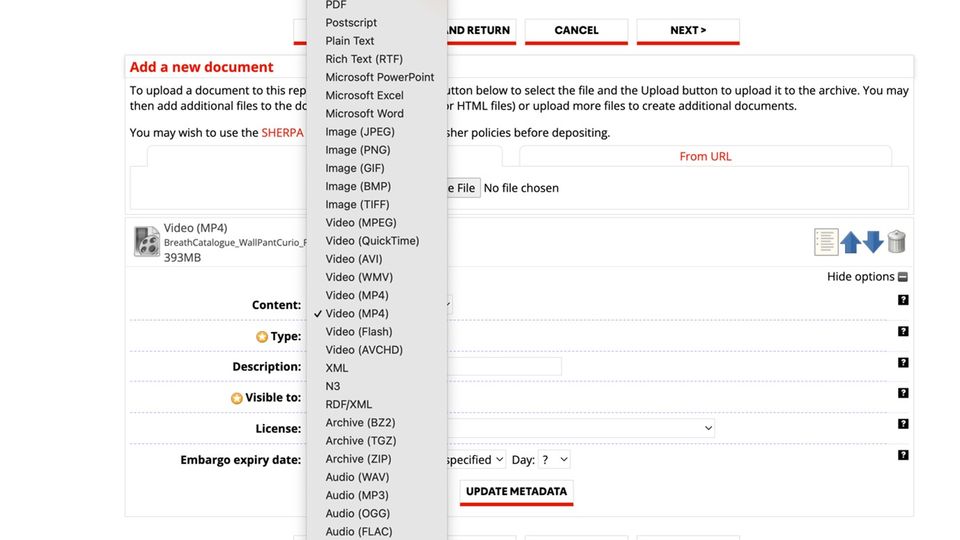
6. Complete the Metadata.
Most journals have an embargo period, which can be checked on the Sherpa Romeo database. If you leave this blank, then Repository staff will complete the embargo information on your behalf before deposits are approved.
7. Once completed, click on Update Metadata and then click on Next.
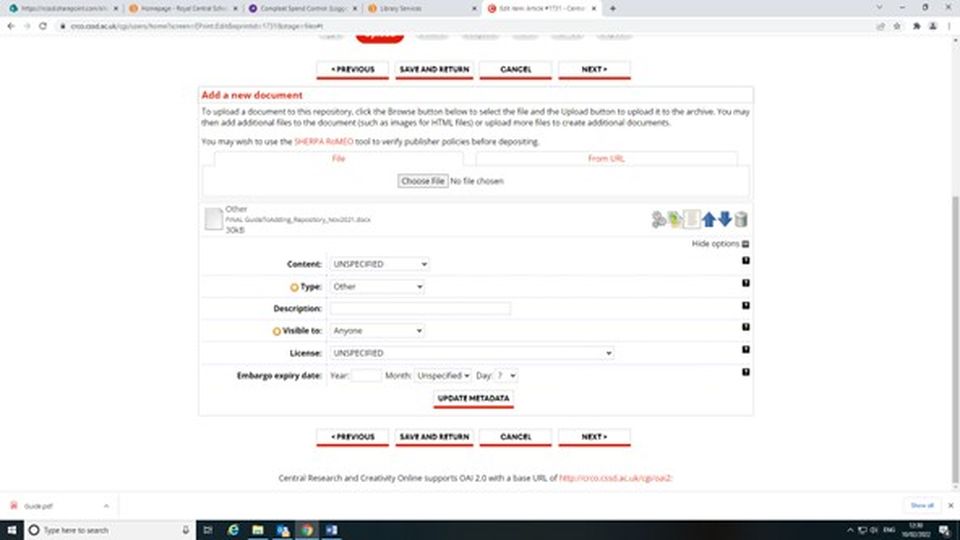
8. Complete the Details page with all the information you know about the output you are depositing.
This includes title, abstract, your name as creator (make sure you also include your Central email address from the drop down menu); other contributors; date of acceptance (journal articles and conference papers); date of publication; all publication details; funder (if there is a funder), project (if your output is part of a larger project); Central contact email; keywords; additional information; and comments and suggestions. All fields marked with stars need to be filled. Fields such as “References” are optional. The more information you provide, the more searchable your output and impact can be measured more accurately. If you are unsure about a field, click the question mark on the right-hand side.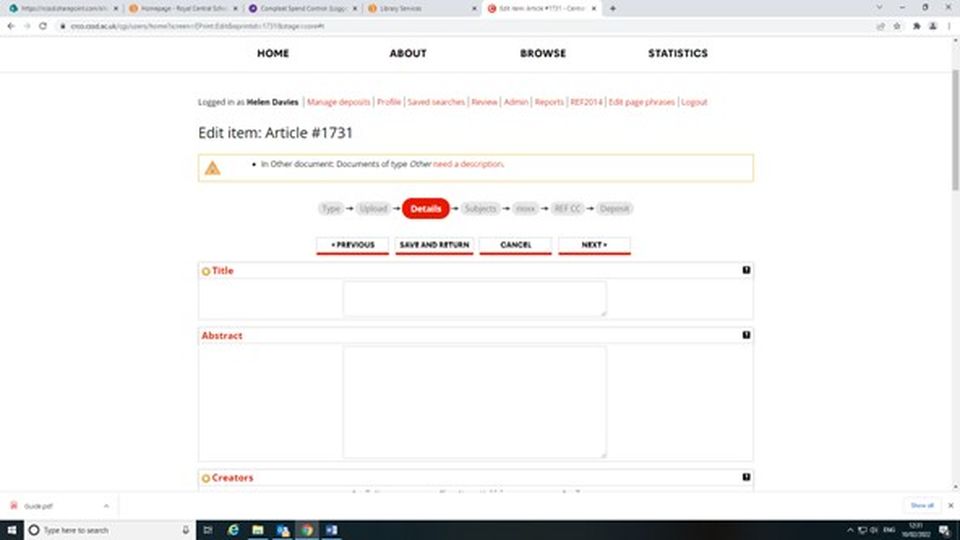
9. For journal articles and conference papers, type in the acceptance date and the publication date, if appropriate. You can always return to add a publication date later.
10. Click on Next.
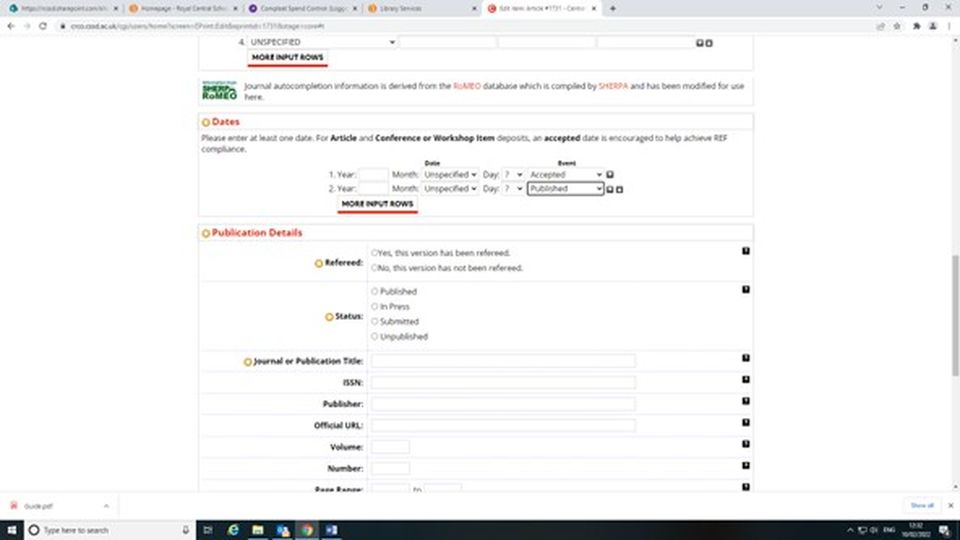
11. Complete the Subject page. Select all the subjects relevant to your output by clicking on add. You can select as many subjects as you feel are relevant. The Dewey Decimal classification is optional.
12. Click on Next.
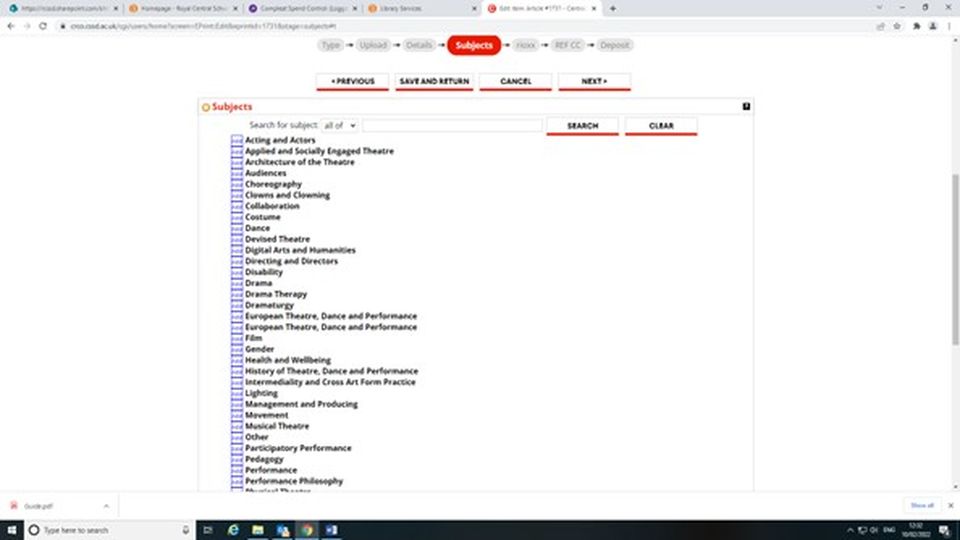
13. If the form remains incomplete, please click on Save for Later and you can return to the output at a later date to complete the task.
14. Once you are happy with the form and the information you have included, click on Deposit Output. Once you have deposited the output you can retrieve the deposit to amend the details (see D).
15. If the following message comes up on the screen - Before depositing this item you must resolve the problems identified - please click on the sections highlighted in blue and complete your data input. Once complete, click on Deposit Output.
16. Following deposit, a Repository Administrator or Manager will review, update and upload your output into the live database. We will only get in touch with you if you have omitted key information or we have a query about your deposit. We agree to make outputs ‘live’ 10 working days after you sent to the output for us to review. Please factor in the potential 10-day delay when depositing items.
Items with the status ‘Under Review’ are waiting to be checked by library staff. You can view these items but not edit them.
Items with the status ‘Live Archive’ have been checked by library staff and are fully live in our Repository.
Items with the status ‘Retired’ are hidden to all.
D. Amending a Deposit in the Institutional Repository
1. To amend an approved deposit in the future, log in and then navigate to the deposit page. At the bottom you will click on View Item (admin only).
2. In the admin screen, navigate to the third tab, which is Actions. There you will have the option to create a New Version, to Use as Template, or to Request Deletion. To edit an existing deposit, click New Version.
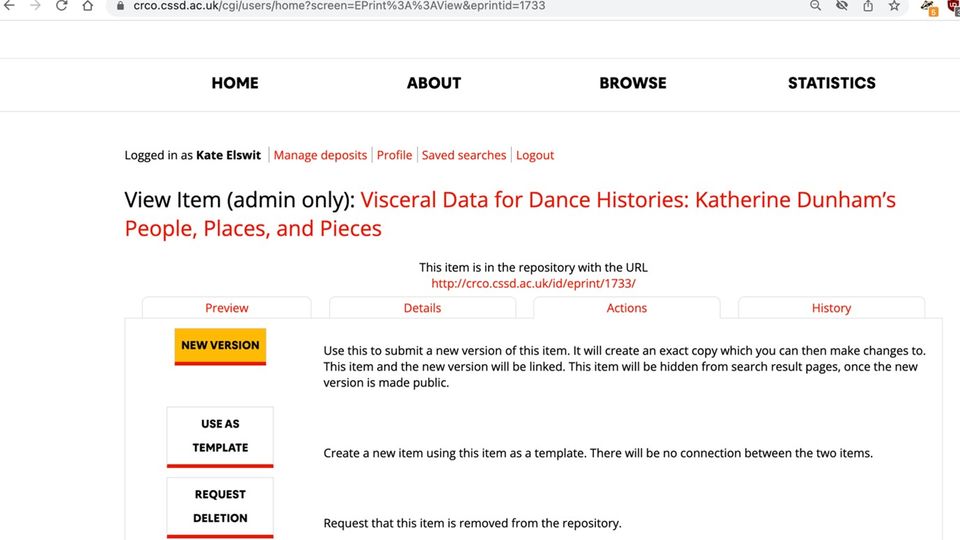
3. Once the new version is created, click on Manage Deposits to the right of your name. This will take you to your work area, where a new version of the item will be created. Click on the pencil icon to edit the deposit. Then proceed to change or update any details necessary and submit as though you are depositing a new item.
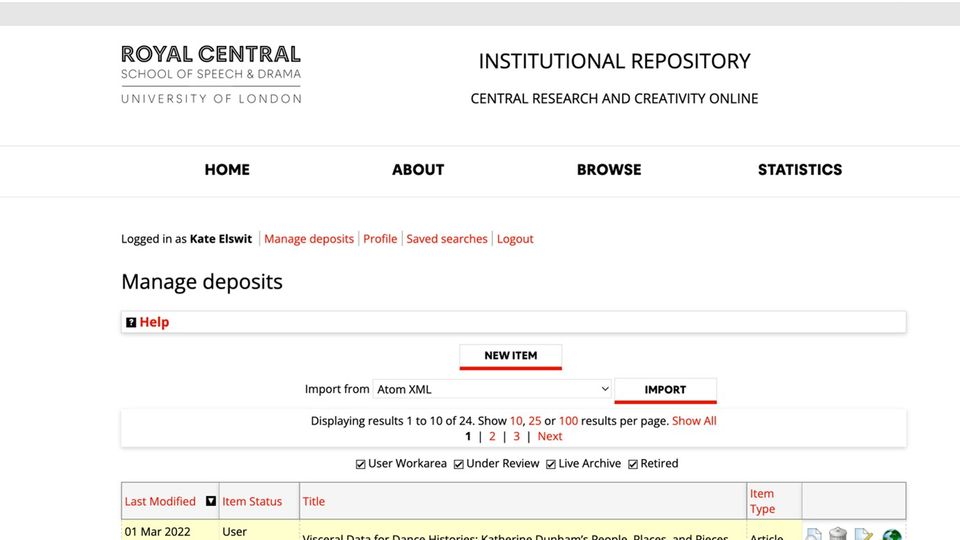
E. After Deposit
1. Please check all your current outputs which appear on our live Repository and gather together information that has not been included, e.g., abstracts and ideas about suitable keywords.
2. Consider arranging a meeting with Helen Davies, the Head of Library Services, where we will review all current outputs to ensure they are comprehensive and accurate. Helen can also answer any questions about uploading outputs into the Repository.
-
Appendix 4: Open Access FAQs
For definitions, such as “author’s accepted manuscript”, please see Appendix 7: Glossary of Key Terms.
Frequently Asked Questions
- How can I make my research Open Access?
- When should I deposit my output in the Institutional Repository?
- If I choose to “self-archive”, which version of my journal article should I place in the IR?
- Is there funding available at Central for paid open access?
- How do I find out about my publisher’s open access policies, including which versions can be made available from my Institutional Repository?
- If my output will be published open access, what do I do differently in submitting it to the Institutional Repository?
- What if I use other repository sites like Academia.edu or a personal website?
1. How can I make my research Open Access?
Open Access relates to full text publications that are free to view online by anyone. That is, there is no fee nor subscription to access the material. There are many ways to achieve open access, and you should choose the journal and/or publisher that is most appropriate for your publication.
Some publications are already available on open access. For instance, Performance Philosophy is a “free to access” online journal. Remember to add the item to the Institutional Repository (IR) with an URL which links to your journal article.
Alternatively upload an article on the IR (“self-archiving”), normally the Author’s Accepted Manuscript. This is often subject to an embargo period set by the publisher, such as twelve months, during which the article is “locked” on the IR. When embargoed, publics can read the metadata including the abstract. After the end of embargo, the full text is free to view and considered open access.
A third option is purchasing paid open access, either for the individual piece (known as Gold access) or as part of a transformative agreement, which will ensure that your article is free to view at point of publication on the publisher’s website and on the IR via an URL. As of 2022, Central is entering into transformative agreements with T&F and with Cambridge UP, through which we pay a lump fee that enables the final version of any journal articles that colleagues publish with those presses to be released as full and immediate open access. If you are not publishing with a journal represented by one of those two presses, then the average cost of publishing an individual essay via Gold access is around £2,000. The author pays the publisher who makes the material freely available on their website free of charge. See Q4 regarding funding available at Central.
It may be possible to make a book or chapter available online as well, subject to publisher permissions. Once permission has been granted, books and chapters can be placed on your website and in the Institutional Repository.
2. When should I deposit my output in the Institutional Repository?
As soon as your item is accepted for publication, please add the item to the IR. This applies to all academic staff whether employed on the Teaching and Scholarship or the Teaching and Research pathway. Later on, it is worthwhile to periodically also revisit the publisher agreements for past publications, as some publishers will allow the Version of Record to be released via an IR or other non-commercial site after a further embargo period.
The 2021 REF Open Access Policy states that journal articles and conference papers with ISSNs that will not be made Open Access via the journal publisher, need to be uploaded within 3 months of acceptance (see Appendix 1). The UKRI Open Access Policy for outputs supported by UKRI funding states that peer reviewed research articles and conference proceedings with ISSNs submitted for publication on or after the 1st April 2022 must be available open access immediately; monographs, book chapters and edited collections published on or after the 1st January 2024 must be available on open access within 12 months of publication (see Appendix 2).
3. If I choose to “self-archive”,which version of my journal article should I place in the IR?
To self-archive, upload the text of the Author’s Accepted Manuscript – the version you sent to the publisher prior to their copy-edits. Appendix 3 includes a style guide to help you format this correctly. The final published version, which has the publishers’ headings and formatting is known as the “Version of Record” and should normally not be uploaded, unless your publisher allows it.
4. Is there funding available at Central for paid open access?
Central has invested funds from our UKRI Block Grant into entering into the JISC deal for transformative agreements with T&F and Cambridge UP. If you have a publication that is not a journal article with one of those presses and would benefit from paid open access, please make an application to Research Services using the Research and Scholarship Funding Application Form, available on MyCentral.
Check on Sherpa Romeo and/or contact your publisher. Publishers should have details of open access policies on their websites.
Add the item to the IR using the deposit form. On the “Details” page provide the URL for the published material. If a DOI has not yet been issued when you are submitting, leave a comment for the Manager of the Repository explaining that this will be Open Access. You will need to return to edit the item after the DOI is issued.
7. What if I use other repository sites like Academia.edu or a personal website?
In addition to depositing items to the Institutional Repository, you are welcome to also share them from other sites subject to publisher embargo rules. In terms of open access permissions, many publishers will allow you to share from a non-commercial website (like the IR or your personal website), but not from a website run by a commercial company (like Academia.edu or ResearchGate). You can find this detail on SherpaRomeo linked from Q5. The item needs to be placed on the IR irrespective of where else you may choose or be allowed to place it.
-
Appendix 5: Open Data Ethics
Central engages with the ten principles of the Concordat on Open Research Data (HEFCE et al, 2016). In addition to those, we specify in relation to our community and our research:
Our data will take many forms. We understand performing arts-related data to represent a range of materials, including, but in no way limited to: curated historical datasets, surveys collected during applied theatre projects, and process notebooks for practice research.
Our data is specific, proportionate, and appropriate at the point of collection. It is developed in relation to particular research processes, and we aim not to collect more than we need. At the point of dissemination, public manifestations of this resource will be curated, in a manner that makes it useful to others.
Our data will be contextualised. It will include user guides, data biographies, or other framing explanations of where the data comes from and how we envision it might be used.
Our data will be cultivated and cared for in ways that protect participants. This includes balancing attribution with anonymity, and not exposing the multiple voices in the data to harm. Where justified and justifiable, our data access will be restricted, with those restrictions documented, revisited, and reviewed.
Our data will require different forms of storage and management, and we will seek appropriate ways to share it. As a small specialist institution, this may rely on external partners and resources. Where data is not held by Central, we will endeavour to generate links from Central’s Institutional Repository, from staff profiles and project websites, and from other outputs themselves, including print publications.
We will account for the variation in our data management, and plan for short-term, medium-term, and long-term sustainability, as feasible and appropriate. We will consider the long-term costs and labour of making our data open access, and maintaining that access.
We recognise the importance of appropriate training for researchers and others working with data, including Library staff, and will endeavour to support anyone engaged in research to develop the appropriate skills to ethically develop, manage, curate, and care for their data.
-
Appendix 6: Open Data Ethics FAQs and Resources
For the principles of Open Data Ethics, please see “Open Data Ethics”, Appendix 5 of Central’s Open Access Policy.
Frequently Asked Questions
- What is data in a performing arts context?
- How do I decide what sort of data I need to collect for my research?
- How do I manage data in a way that protects participants?
- How and why would I share my research data?
- What constitutes a reasonable Data Management Plan?
- How might I contextualise my data?
- What do I need to think about when storing my data?
- What is metadata? What are metadata standards?
What could a Data Access or Data Availability Statement look like?
- Where can I find training and support?
1. What is data in a performing arts context?
In the arts and humanities, researchers are often more inclined to think of having “research materials” than of having “data.” However, there is a lot of overlap. The current push toward open data challenges researchers to consider how to curate and cultivate materials generated in the process of research in a manner that makes them more reusable by others.
Understanding “data” (and what “data” is for any research project) is a useful way of deepening understanding about the research itself, including its aims and objectives. The Concordat on Open Research Data (2016) defines “data” as follows:
Research data are the evidence that underpins the answer to the research question, and can be used to validate findings regardless of its form (e.g. print, digital, or physical). These might be quantitative information or qualitative statements collected by researchers in the course of their work by experimentation, observation, modelling, interview or other methods, or information derived from existing evidence. Data may be raw or primary (e.g. direct from measurement or collection) or derived from primary data for subsequent analysis or interpretation (e.g. cleaned up or as an extract from a larger data set), or derived from existing sources where the rights may be held by others. Data may be defined as ‘relational’ or ‘functional’ components of research, thus signaling that their identification and value lies in whether and how researchers use them as evidence for claims.
They may include, for example, statistics, collections of digital images, sound recordings, transcripts of interviews, survey data and fieldwork observations with appropriate annotations, an interpretation, an artwork, archives, found objects, published texts or a manuscript.
In the performing arts, research data might include curated historical datasets, surveys collected during applied theatre projects, and process notebooks for practice research or making a performance. It might include the feelings experienced when watching a performance noted down during or after, the embodied experience of making or watching a piece of work, or any number of ephemera that we encounter in this field.
2. How do I decide what sort of data I need to collect for my research?
Researchers sometimes want to collect as much data as possible just in case, so that they can decide what to do with it later. However, it is increasingly important to be specific about what data is being collected and why. For example, when conducting a survey or interviews, is knowing the gender of the respondents necessary? If the research is about gender, then yes. If it is not, it is important to ask why that data is being collected and how it will be useful for the research.
In more complex circumstances, where data is not as clear cut as information provided directly from participants, for example, where observing rehearsals and taking notes or using feelings and responses to performance, then returning to the research questions is important. Clear research questions can ensure the data collected is both useful for the research and specific.
When working with others, it is important they know what data is being collected. For example, when researching a production and observing a rehearsal, the actors or participants should have a clear sense of the limits of what is being attended to, not just in terms of their personal characteristics, but also about actions and behaviours.
3. How do I manage data in a way that protects participants?
The multiple stakeholders of data – such as participants and contributors, recipients and beneficiaries, funders and repositories, and researchers themselves – may present different needs and agendas to be negotiated in data collection and management. Collecting data ‘care-fully’ involves balancing the need for attribution and recognition of participants with the ethical imperative to avoid harm. Anonymisation and pseudonymisation, for example, can be used to mitigate the risks of exposure for participants. However, anonymisation is not always appropriate – for example, when acknowledging participants’ creative or authorial work, or when participants feel that research holds the potential to amplify their voices in specific ways that are not compatible with anonymisation. Researchers should always be transparent with participants about how their data is managed, shared and protected, and this should be discussed in establishing informed consent. Where justifiable, data access can be restricted, with those restrictions documented, revisited and reviewed.
4. How and why would I share my research data?
UK Research and Innovation state that: “Making your data as open as possible means that publicly funded research is more: transparent and easily scrutinised, helping to increase public trust; easy to re-use and build upon; collaborative and efficient” (UKRI, 2022).
Whilst there may be circumstances where due to security, confidentiality or commercial reasons it is important to restrict data, funders increasingly expect research data to be as open as possible. Furthermore, making research data open can be particularly important when working with data that might have long-term value — such as research with and about marginalised communities or groups.
Think of a curated and cultivated approach to open data as a way to fill out beyond what you might have published via other means. Sometimes when writing up research, there are key bits of information (responses from participants, images of performances, notes from rehearsals and so on) that we are excited by or we think should be shared widely, but are not within the scope of the particular research output we are working on. Sharing your data and making it accessible is a useful way of ensuring these research findings are available, shareable and reusable even when they do not make it into the particularly research outputs of any given bit of research.
There is no singular way to share research data, as each bit of research will have different forms of data which may be collected and stored in ways unique to that research project. However, researchers can be supported in scoping out and designing the most appropriate ways to disseminate research data (which can – and indeed should, where possible – be connected to how this data is collected). Rather than a one-size-fits-all approach, researchers are encouraged to explore the most appropriate ways of sharing their data to support their research from the start of the project. The more complex the project, the more likely a custom approach is needed.
5. What constitutes a reasonable Data Management Plan?
A reasonable Data Management Plan (DMP) should show that the sustainability horizons for all aspects of a project’s research data have been considered. For example, the Feminist Data Manifest-No advocates for refusing “the use of data about people in perpetuity.” At the same time, oral history data can circumvent standard General Data Protection Regulation (GDPR) horizons, because it constitutes “archiving in the public interest.” So, what is reasonable and meaningful to stay around, and what could cause harm? In addition, a DMP should account realistically for the costs, timelines, and technological implications of ongoing preservation. For example, a document or spreadsheet might be stored in a way that is accessible much longer than a web-based experience; you could screen-grab a video of a web-based experience, but video files will still become obsolete without file conversion sooner than some other file types.
With every bit of research, it is important to consider how the data is managed, not just how and where it is stored but how it can be easily accessed and shared. Having a Data Management Plan is something which is increasingly important to funders, including UK Research and Innovation (UKRI) and specific bodies within UKRI such as the Arts and Humanities Research Council (AHRC). A DMP should help researchers to consider all the important aspects of their research in relation to data – from what the data is, to how it will be collected and stored, to how the data will be cared for and curated before it is disseminated.
6. How might I contextualise my data?
Data contextualisation includes user guides, data biographies or other framing explanations of where the data comes from and how researchers envision it might be used. A key aspect of countering the supposed neutrality of data and ensuring proper reuse is to provide context about the process of collection and curation. As the Feminist Data Manifest-No puts it: “We refuse to consider data as raw and only an end product without context and values and to ignore that data has an origin story, and a creator or creators whose legacy must be understood in order to understand the data itself.”
So, what does a particular parameter really mean? Who or what was included or not? Who or what do the researchers know was not included? Two ways to push future users beyond taking research data at face value are to produce a data biography and/or a user guide. A simple data biography tells the story of the data, by providing information about who created this data, and how, where, when, and why it was collected. The resources below also link to a more complex data biography builder that focuses specifically on equity. A user guide provides a broader range of study-level documentation, from the contexts and methods employed in data collection to the assumptions underlying each datapoint.
Further, contextualization might include information on the structure of the data itself, and any conditions on future usage. For further information on data curation for reuse and on “justified and justifiable” restrictions on data use, see Principle #2 and Principle #7 of the Concordat on Open Research Data.
7. What do I need to think about when storing my data?
When thinking about data storage, researchers might ask the following questions:
What’s backed-up? – all, some or just the bits you change?
Where? – original copy, external local and remote copies?
What media? – DVD, external hard drive, USB, Cloud?
How often? - hourly, daily, weekly? Automate the process?
What method/software? – duplicating, syncing or mirroring?
For how long is it kept? – are there data retention policies that might apply?
When is it destroyed – is there a schedule for this? The only sure way to ensure data is irretrievable is to physically destroy the drive (using an approved secure destruction facility).
Data management plans should include a suitable backup to alleviate the risk of the loss of data through damage/accident, or criminal infiltration. At the same time, the more places data is stored, the more researchers need to think about securing it. When dealing with data of a sensitive or confidential nature, it is particularly important to ensure that the storage of such information is suitably protected/encrypted. If a research project uses cloud servers, some funders may require them to be located on servers within the UK and EU. The UK Data Service recommends Pretty Good Privacy (PGP), which is more complicated than just a password, but much more secure, and involves use of multiple public and private keys. Researchers may want to keep passwords and keys on paper (2 copies) and in a PGP (pretty good privacy) encrypted digital file.
8. What is metadata? What are metadata standards?
Metadata is data about data – or asset of data that describes of gives information about other data. Metadata is used to give clearer understandings of data and datasets for those who might use them, helping them find relevant information or more easily discover resources. Adhering to pre-existing metadata standards can help to describe data in a consistent manner to ensure the usability of the metadata; however, findability and usability may differ for different contexts, so consider the knowledge structures to which the standard or standards you choose belong and the worldviews that they promote. Metadata can include descriptive information, as well as further details about provenance and access to and future use of data.
9: What could a Data Access or Data Availability Statement look like?
Your data access statement is included in the publication itself, and tells readers where they might be able to find supplemental materials, including underlying data and/or evidence to support your claims, or why none are available. An aspect of this is already covered by standard citational practices in our field of referencing primary and secondary sources in a manner that future researchers can find them again. In addition, there may be materials that you specifically gathered and collated, such as audience surveys or interviews, that may be useful to future researchers. If those materials have been held on a publisher’s website or in a data repository, then your data access statement might say something like “the research materials described have been deposited with … .”
Or alternately, they might be “available upon request from the author(s).” If there are restrictions or embargoes on the use of those materials, then there should be an explanation of why these are restricted and the terms under which they might be accessed. If the underlying data is completely unavailable, a data access statement needs to explain the rationale. Cambridge UP has a useful table of data availability statement templates under various conditions, ranging from “Data openly available in a public repository, with a permanent identifier” to “Data available on request due to privacy/ethical restrictions.”
10. Where can I find training and support?
Vitae is a globally recognised organisation that works to support the professional development of researchers. They offer training and it is free to register and access all sorts of resources. Jisc (another organisation that supports UK research and education) offers a thorough, step by step, Research Data Management Tool Kit. Another place for advice and practical help with research data management is the Digital Curation Centre.
Some individuals at Central who might be able to support researchers in thinking about sharing research data from as early as possible are Research Advisors, the Chair of the Research Ethics and Integrity Sub-Committee, the Open Data Ethics Working Party, and the Head of Digital Research. Please email the ethics team at Central with any questions.
Resources
- General Overviews
- What is performing arts data?
- What should I collect and disseminate?
- Contextualising your data
- Protecting participants
- Metadata
- Data management plans
- Storage and sharing
- Training and support?
Concordat on Open Research Data (2016)
Practicing Ethics Case Studies - Case studies with insights into ethical dilemmas that can arise during research
Re3Data - Global registry of research data repositories
2. What is performing arts data?
Arts and Humanities Data Service – Archived project promoting shared standards and preserving examples of research and teaching in the arts and humanities
The Alan Turing Institute – Humanities and data science
What’s so different about arts and humanities data? – Presentation about arts and humanities data
Humanities, arts & culture data – Australian project supporting data-enabled research
3. What should I collect and disseminate?
Arts Council England – Public page about Arts Council data and their data principles
UCL – Teaching materials and guidance for arts and humanities data and data management plans
Creative Equity Toolkit – Making your data collection fun
The Feminist Data Manifest-No (2019) – Manifesto refusing harmful data regimes and committing to new data futures
An Introduction to the Data Biography (2019) – Getting started with data biographies
Data Biographies: Getting to Know Your Data (2017)
We All Count Data Biography Builder (2019) – Dataset bias assessment tool
Managing and Sharing Data: Best Practices for Researchers (2011) – UK Data Archive best practice guidelines
General Data Protection Regulation – Guide to UK GDPR
Practising Ethics: Confidentiality
Metadata: Distributed Active Archive Center (Oak Ridge National Laboratory)
Schema Library (Altova) of common industry and cross-industry standards
Seeing Standards: A Visualization of the Metadata Universe documents 105 standards used by the cultural heritage community
DDI: Metadata specification for the social and behavioural sciences
Astronomy Visualization Metadata
Content Standard for Digital Geospatial Metadata (more on metadata from the FGDC)
Arts and Humanities Research Council (AHRC) data management plans – Guidance from the Open University
New AHRC data management plan template (2018) – post from the Digital Curation Centre
AHRC Technical Plan compliance rubric - Digital Curation Centre
Plan to make data work for you - Digital Curation Centre
What is a data management plan? - UKRI
Making your research data open – UK Research and Innovation (UKRI) webpages
How to share research data – Imperial College London guidance
6 repositories to share your research data – From the Teamscope data collection app
Sustainable and FAIR Data Sharing in the Humanities (2020) – All European Academies (ALLEA) report
What is data in the humanities and how you can make the most from your hard-earned research data? (2019) – Presentation from Digital Research Infrastructure for the Arts and Humanities (DARIAH-EU)
Research data in the creative and performing arts (2016) – JISC article
Scoping the connections between trusted arts and humanities data repositories (2022) – British Library digital scholarship blog
In the humanities data is not just numbers (2021) – Wonkhe article
Open research data repositories: Practices, norms, and metadata for sharing images (2021) – Article
Arkivum - Data archiving solution
Oral history and personal data: recording, archiving and re-use under GDPR – British Library presentation
Purdue University Libraries has a very useful guide for addressing issues with sharing research data involving human subjects or other sensitive data sets.
Vitae – organisation supporting the professional development of researchers
Career and professional development training – Vitae
Doing research – Vitae toolkits, register to access
Research data management toolkit – Thorough, step by step toolkit from Jisc
Training and resources for research data management – from Jisc
Data Tree – Free online course on research data management aimed at early career researchers
Research and data ethics – Free online course
Digital Curation Centre - advice and practical help with research data management
How-to guides – DCC
How to license research data (2014) – DCC
-
Appendix 7: Glossary
Glossary of terms used in Central’s Open Access Policy
Author’s Accepted Manuscript
Final version of your peer-reviewed manuscript, prior to copy-edits. Not the publisher’s version.
Acceptance Date
Date your output was accepted by the publisher in a letter or email. This is not the same as the publication date.
Article Processing Charge
Also known as an APC. A publisher’s charge to enable free full open access to publics.
Creative Commons Licences (CC)
Also known as CC. A range of copyright licences, which enables creators to select the most suitable reader entitlements.
CC-BY 2.0
A Creative Commons License which allows publics to copy, adapt, remix, transform and redistribute the material for any purpose including commercial purposes. The reader must credit the licensor and indicate adaptations but must not make a claim that the originator endorses the new work or apply restrictions to the adapted work that stops others doing what the licensor permitted.
CC-BY-NC 2.0
Another type of Creative Commons License which allows the reader to do the same as the CC-BY but not use the material for commercial use.
Deposit
Process of adding an output to the Institutional Repository.
Discoverable
The output can be found by readers searching online
DOI
A unique identifier attributed to the manuscript
ePrints
Eprints is a digital platform developed by Southampton University, which supports our Institutional Repository
Embargo
Time set by publishers which determines how long the item remains in lock down
Gold Access for Journal Articles
A type of open access publishing for journal articles. On payment of an APC, there is free public access at point of publication.
Green Access for Journal Articles
A type of open access publishing for journals, which allows creators to place their final accepted manuscript in a repository subject to the publisher’s embargo
Institutional Repository (IR)
A database which stores, arranges and makes outputs fully accessible to the public free of charge
Item Type
Refers to the type of item such as book, chapter, journal article, video etc.
Metadata
Information relating to the output which includes the bibliographic information plus abstract and subject information. Metadata helps to make outputs findable online
Open Access
Research that is available online free of charge to publics
ORCID
Also known as Open Researcher and Contributor ID. This is a unique number that identifies an individual author. We recommend all researchers at Central obtain ORCID IDs
Output
An output can be any of, but not limited to, the following item types: advisory reports and evaluations, books authored and edited (including translations and scholarly editions), chapters in books, thesis, advisory reports and evaluations, journal articles, published conference papers, working papers’, compositions and musical scores, creative writing (libretti, film scripts, radio plays, novels, short stories, stage plays), performances, films, video and media presentations, installations, exhibitions and exhibition catalogues, artefacts, designs, devices and products, databases, digital and visual media, software design and development, websites, electronic resources and publications, research data sets and patents.
Plan S
An open access campaign led by the European initiative coalition S. The 2021 UKRI Open Access Policy is meant to align with some of the principles of Plan S.
Pre-Print
Article before peer review and possibly before contact with a publisher
Research Excellence Framework (REF)
A research assessment exercise conducted in 2014 and 2021 that assesses the quality of research across the UK’s Higher Education Institutions (HEIs). Quality Related (QR) research funding is subsequently allocated to HEIs on the basis of REF scores.
Self-Archiving
Process of making your research available for others to read free of charge. Central’s research funders recommend submitting the Author’s Accepted Manuscript to the Institutional Repository
Sherpa RoMEO
A database, which sets out publisher rules about embargo periods.
Transformative Agreement
Transformative agreements are contracts negotiated between institutions and publishers, which facilitate open access for journal publications across the institution, rather than on an output by output basis.
UKRI
United Kingdom Research and Innovation, which brings together the UK’s seven disciplinary research councils, Research England, and Innovate UK.
Version of Record
Publisher’s version of a manuscript which includes the headings and typeset.
